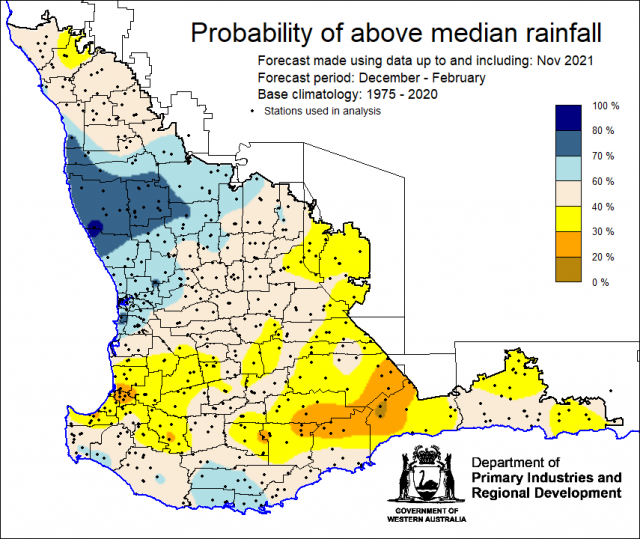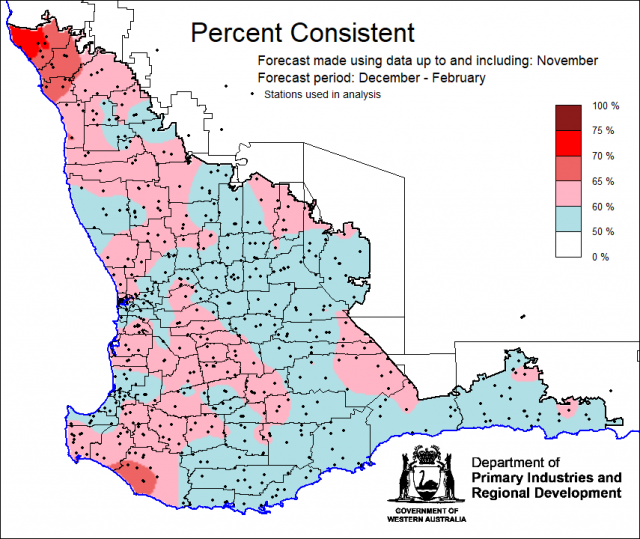Summary
The Department of Primary Industries and Regional Development’s (DPIRD) Statistical Seasonal Forecast (SSF) outlook for summer, December 2021 to February 2022 is indicating mixed chances of exceeding median rainfall for the South West Land Division (SWLD).
- For summer, December 2021 to February 2022, the SSF is indicating above 60% chance of exceeding median rainfall for parts of Central West, Central Wheatbelt and South Coastal forecast districts. Less than 40% chance for parts of South West, Great Southern and South East Coastal forecast districts. Neutral (40-60%) chances elsewhere. The most probable rainfall decile map indicates decile 2-3 for parts of South West, Great Southern and South East Coastal forecast districts. Decile 8-10 for parts of Central West, Central Wheatbelt and South Coastal forecast districts and decile 4-7 elsewhere. Predictive skill based on November conditions is mostly poor to good (50-75% consistent).
- The Bureau of Meteorology’s seasonal outlook for summer December 2021 to February 2022 is indicating 45-55% chance of above median rainfall for the majority of the SWLD. Predictive skill is poor to good (55-75% consistent). The longer term outlook for January to March 2022 is also neutral, with wetter chances for Great Southern and South Coastal forecast districts. Skill is poor to moderate (50-65%).
- Temperature outlooks from the Bureau for November 2021 to January 2022 indicate a 35-80% chance of above average day-time maxima (with lower chances for the Great Southern and South Coastal forecast districts). Skill is 55-75%. The Bureau indicates 60-80% chance of exceeding above average night-time minima for the SWLD. Skill is 55-75%.
- November rainfall was generally below average to average for the SWLD, but heavy falls and hail delayed grain harvest in the Central Wheatbelt and Great Southern. November maximum temperatures were below average to average and minimum temperatures were average.
- The main climate driver influencing the SWLD is the La Niña in the Pacific. Based on past events, the SWLD is expected to have average rainfall over summer. The Southern Annular Mode remains positive, but has no influence on SWLD climate in summer.
Three Month Outlook for the south-west of Western Australia
Statistical Seasonal Forecasting (SSF)
DPIRD’s Statistical Seasonal Forecast (SSF) system uses historical relationships between global sea surface temperature and sea level pressure with rainfall in south-west Australia, to produce forecasts of rainfall for the coming months. Users can click on any station indicated on the map on DPIRD’s Seasonal Climate Information pages for location-specific forecast information.
For summer, December 2021 to February 2022, the SSF is indicating above 60% chance of exceeding median rainfall for parts of Central West, Central Wheatbelt and South Coastal forecast districts. Less than 40% chance for parts of South West, Great Southern and South East coastal forecast districts. Neutral (40-60%) chances elsewhere. The most probable rainfall decile map indicates decile 2-3 for parts of South West, Great Southern and South East coastal forecast districts. Decile 8-10 for parts of Central West, Central Wheatbelt and South Coastal forecast districts and decile 4-7, elsewhere. Predictive skill based on November conditions is mostly poor to good (50-75% consistent).


